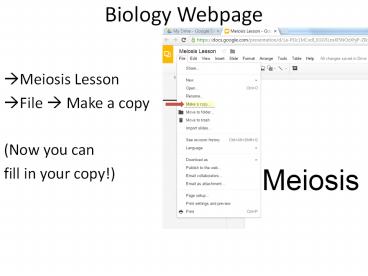Biology Webpage - PowerPoint PPT Presentation
1 / 25
Title: Biology Webpage
1
Biology Webpage
- Meiosis Lesson
- File ? Make a copy
- (Now you can
- fill in your copy!)
2
Meiosis
3
How are human and animal chromosomes categorized?
- Sex chromosomes- the 23rd pair of chromosomes
determines the gender of an organism and they
also carry genes for other traits. - Female XX
- Male XY
- Autosomes- All other chromosome pairs
- (1-22) which code for all the other traits.
4
How many chromosomes are there in human cells?
- Humans have 23 pairs or a total of 46
chromosomes.
5
What are homologous chromosomes?
- Every organism produced by sexual reproduction
has two copies of each autosome - (one from each parent)
- Homologous chromosomes or homologues Two copies
of each autosome - - Same size
- - Same shape
- - nCarry genes for the same trait
6
Journal
- What is the difference between
- sister chromatids and homologues?
7
Diploid number of chromosomes
- Cells having two sets of chromosomes are said to
be diploid they have both chromosomes for each
homologous pair. - All body cells have a diploid number of
chromosomes - Also referred to as 2n, 2(23)46
8
Haploid number of chromosomes
- Cells contain only one set of chromosomes they
have half the normal or diploid number of
chromosomes. - Only the reproductive cells called gametes (sperm
and egg cells in humans) have haploid number. - Also referred to as 1n, 1(23)23
9
Haploid (n7)
Diploid (2n 14)
10
Haploid Gametes 1n (Reproductive Cells)
Diploid zygote 2n (Offspring- also called a
zygote)
11
Journal
- What is the difference between haploid and
diploid?
12
Meiosis
- Nuclear division that reduces the number of
chromosomes in the new cells produced
half_(haploid) the number in the original cell. - In males this takes place in the sperm. It is
called spermatogenesis. - In females this takes place in the egg and it is
called oogenesis.
13
Meiosis has 2 parts
- Meiosis I- Homologous chromosomes are separated
- Meiosis II-
- _Sister chromatids are separated
14
- Meiosis I
- Prophase I- chromosomes are paired with
homologues to form tetrads - M etaphase I- Homologues meet in the middle
- A naphase I- Homologues are pulled apart
- T elophase I- Two nuclei are formed
- Cytokinesis- Splits into two haploid cells
15
- Meiosis II
- Prophase II- Nuclear membrane disappears
- M etaphase II- Chromosomes meet in the middle
- A naphase II- Sister Chromatids are pulled apart
- Telophase II- Two nuclei form
- Cytokinesis- Four haploid cells are formed
16
(No Transcript)
17
(No Transcript)
18
Meiosis Provides Genetic Variation
- Recombination Prophase I homologues chromsomes
_cross over and genetic material may be
exchanged.
19
Meiosis Provides Genetic Variation
- Law of Independent Assortment Homologues line
up independently of each other!
20
Journal
- What are the 2 ways that Meiosis
- provides for genetic variation?
21
Nondisjunction
- When homologous chromosomes _fail_ to separate
properly during meiosis. - Results
- A gamete with an extra
- chromosome (trisomy)
- A gamete missing a
- chromosome (monosomy)
22
(No Transcript)
23
Trisomy 21
24
Polyploidy
- Organisms with more than the usual number of
chromsomes - Occurs in plants
- Caused by self fertilization
25
- THE END!































